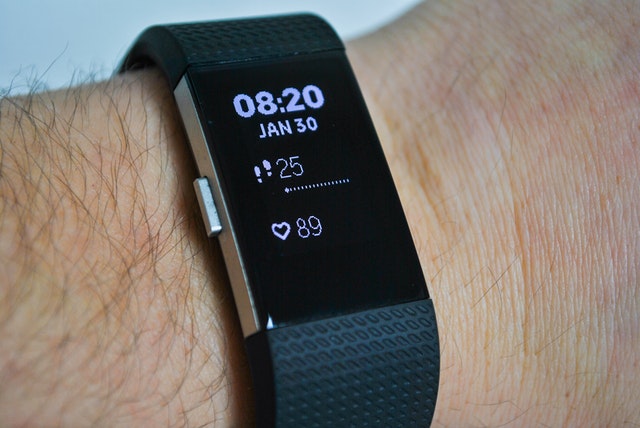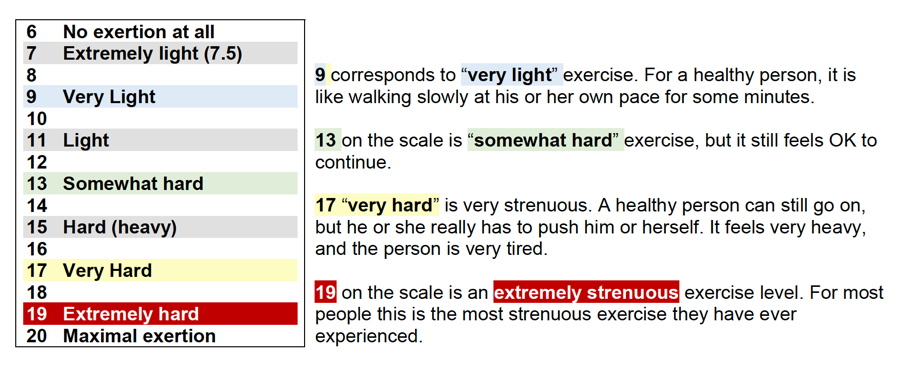3 1.3 Measures of Physical Activity
Measuring physical activity and fitness is a vital step in better understanding one’s overall health. Various measurement strategies may be utilized when assessing your own level, or others’ level, of physical activity participation. Often, measurement strategies differ dependent upon whether the environment is field-based (i.e., sport performance) or research-based.
Several frequently used field-based assessment methods include:
- Intensity Rating
- Heart Rate
- Rating of Perceived Exertion (RPE)
- Energy Cost
- Step-Count Data.
Assessment methods commonly used in research include:
- Metabolic Equivalents (METs)
- Activity Monitor Data (i.e., Accelerometers)
Field-Based Physical Activity Assessment Methods
Intensity: Refers to work or effort exerted to perform activity or exercise. Relative intensity may be determined by focusing on heart rate and breathing patterns while engaging in activity. Intensity ratings are as follows: Sedentary, light intensity, moderate-intensity, vigorous intensity (Centers for Disease Control and Prevention, 2015a). Note: Absolute intensity is determined by metabolic equivalent (MET) methodology.
A common method of monitoring physical activity intensity is by calculating heart rate, and determining if the target heart rate zone has been reached Heart Rate: A common method of monitoring physical activity intensity is by calculating heart rate, and determining if the target heart rate zone has been reached.6 The equations below may be utilized to determine resting heart rate, maximum heart rate, and target heart rates for moderate-intensity and vigorous-intensity physical activity (Centers for Disease Control and Prevention, 2015c; American College of Sports Medicine, 2013).

Photo by Philip Lindvall.
Resting Heart Rate: The number of heart beats per minute (bpm) when the body is not engaged in physical activity. An individual may take their resting heart rate at the neck, wrist, or chest. The recommended location is to place the index and middle finger lightly on the radial pulse on the wrist. Count the number of heartbeats within sixty seconds, or count the number of heartbeats in thirty seconds and multiply this answer by two (Centers for Disease Control and Prevention, 2015c). For the most valid measurement of resting heart rate, it is advised the individuals take this measurement in the morning prior to getting out of bed.
Maximum Heart Rate: the age-related number of beats per minute of the heart when working at its maximum; usually estimated at 220 minus the individual’s age (Centers for Disease Control and Prevention, 2015c; American College of Sports Medicine, 2013).
Note: New Maximum Heart Rate formulas have been utilized in recent years. Several alternatives to the aforementioned formula are: 206 – (0.67 x individual’s age); 208 – (0.7 x individual’s age).
Heart Rate Reserve: the Karvonen Method of Heart Rate Reserve (HRR) is utilized to determine an individual’s target training heart rate by incorporating resting heart rate into the formula; thus, reducing risk of undertraining or overtraining. HRR is calculated by subtracting resting heart rate from maximum heart rate (American College of Sports Medicine, 2013).
Example:
Heart Rate Reserve (HRR) = maximum heart rate (max HR) – resting heart rate (resting HR).
A 30-year-old individual; 220 – 30 = maximum heart rate (max HR) of 190 bpm. Resting heart rate (resting HR) is 60 bpm.
HRR (190 – 60) = 130 bpm.
Target Heart Rate: An individual’s target heart rate is a calculation of HRR multiplied by a target intensity level (a percentage), in addition to the individual’s resting heart rate. The following calculation is an example of a training heart rate for a 25-year-old individual; resting HR = 65 bpm; intensity level of 60-70%.7
Example:
Target Heart Rate = ((max HR − resting HR) × %Intensity) + resting HR.
220- 25 (age) = 195.
195 – 65 (resting HR) = 130 (HRR).
(130 x .60) (minimum target intensity) + 65 (resting HR) = 143 bpm.
(130 x .70) (maximum target heart rate) + 65 (resting HR) = 156 BPM.
Target heart rate for training session = 143-156 bpm.
Comprehension check:
Calculate your resting heart rate, maximum heart rate, heart rate reserve, and target heart rates for 60% and 80% intensity level.
Rating of Perceived Exertion: RPE is a measure of physical activity intensity level which relies upon the individual’s personal perception of how much effort is being exerted during activity. Although this measure is somewhat subjective, the Borg Rating of Perceived Exertion Scale (Figure 1) appears to be a reasonably accurate estimate of heart rate during physical activity (Centers for Disease Control and Prevention, 2015b; Norton, Norton, L & Sadgrove, 2010). The scale ranges from 6-20, with 6 representing “no exertion” and 20 representing “maximal exertion.” A range of 12-13 on the Borg Scale generally represents “moderate-intensity” physical activity (Centers for Disease Control and Prevention, 2015b).

guidelines advisory committee report, 2008. Washington, DC: US Department
of Health and Human Services, 2008, A1-H14. Image from CDC Perceived Exertion document.
Comprehension check:
What exercise would a RPE of 10-11 represent for you? Could you alter or adapt this exercise to reach an RPE which signifies vigorous-intensity physical activity?
Energy Cost: Energy expenditure (calories “burned”) may be estimated by taking into account the individual’s body weight, activity type, and physical activity intensity level (Ainsworth et. al., 2011; Ainsworth et. al., 2016). Note: Current compendiums of physical activity energy expenditures are available at: https://sites.google.com/site/compendiumofphysicalactivities/
Step-Count Data: Physical activity may be measured by wearable devices which record step-count data, such as pedometers. Wearable devices which provide immediate feedback regarding step-count data have been associated with increases in physical activity (Bravata et. al., 2007). A common minimum recommendation for health is to aim for at least 10,000 steps-per-day (Bravata et. al., 2007). However, upcoming physical activity guidelines may increase the recommendation for daily step count to 15,000 steps-per-day.
Note: Pedometers are devices which measure steps or count data, and specific step count cutoffs may be utilized to approximate intensity levels. However, pedometers cannot directly measure physical activity intensity.

Research-Based Activity Assessment Methods
Metabolic Equivalents: METs are commonly utilized in physical activity research to measure intensity levels (American College of Sports Medicine, 2013). METs measure these exercise intensity levels based upon oxygen consumption of the body. MET intensity level cut-points are categorized as follows:
1 MET = Resting Metabolic Rate
1.0-1.5 MET = Sedentary Behavior
1.6-2.9 MET = Light Intensity
3.0-5.9 MET = Moderate Intensity
≥6.0 MET = Vigorous Intensity
(American College of Sports Medicine, 2013; Ainsworth et. al., 2011).
Comprehension check:
How are MET measures and the Borg Rating of Perceived Exertion (RPE) Scale similar? In what ways do these two measures of physical activity differ?
Accelerometer: A movement monitor which has capabilities to record step-count data, as well as physical activity intensity levels (Troiano, 2008). Accelerometers measure an individual’s acceleration forces on one, two, or three planes (axis) of motion. Accelerometers are often utilized in physical activity research studies.
Works Cited:
Ainsworth, B. E., Haskell, W. L., Herrmann, S. D., Meckes, N., Bassett Jr, D. R., Tudor-Locke, C., Greer, J. L., Vezina, J., Whitt-Glover, M. C. and Leon, A. S. (2011). 2011 Compendium of Physical Activities: a second update of codes and MET values. Medicine and science in sports and exercise, 43(8), 1575-1581.
Ainsworth B. E., Haskell W. L., Herrmann S. D., Meckes N., Bassett Jr D. R., Tudor-Locke C., Greer J. L., Vezina J., Whitt-Glover M. C., Leon A. S. (2016). The Compendium of Physical Activities Tracking Guide. Retrieved from
https://sites.google.com/site/compendiumofphysicalactivities/
American College of Sports Medicine (2013). ACSM’s guidelines for exercise testing and prescription. Lippincott Williams & Wilkins.
Bravata, D. M., Smith-Spangler, C., Sundaram, V., Gienger, A. L., Lin, N., Lewis, R., Stave, C. D., Olkin, I., & Sirard, J. R. (2007). Using pedometers to increase physical activity and improve health: a systematic review. Jama, 298(19), 2296-2304.
Centers for Disease Control and Prevention (2015a). Physical activity: Measuring physical activity intensity. Retrieved from https://www.cdc.gov/physicalactivity/basics/measuring/index.html
Centers for Disease Control and Prevention (2015b). Physical activity: Perceived exertion (Borg rating of perceived exertion scale). Retrieved from https://www.cdc.gov/physicalactivity/basics/measuring/exertion.htm
Centers for Disease Control and Prevention (2015c). Physical activity: Target heartrate and estimated maximum heart rate. Retrieved from https://www.cdc.gov/physicalactivity/basics/measuring/heartrate.htm
Norton, K., Norton, L., & Sadgrove, D. (2010). Position statement on physical activity and exercise intensity terminology. Journal of Science and Medicine in Sport, 13(5), 496-502.
Troiano, R. P., Berrigan, D., Dodd, K. W., Masse, L. C., Tilert, T., & McDowell, M. (2008). Physical activity in the United States measured by accelerometer. Medicine and science in sports and exercise, 40(1), 181.

